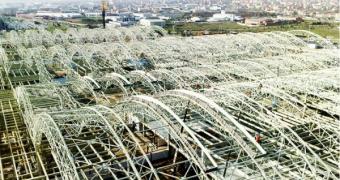Just recently, the city of Istanbul saw the opening and commissioning of the world's largest and safest earthquake-proof building in the world. The structure covers an impressive area, but it's completely isolated from the ground below. It does not rest on the soil, but rather on a few hundred bearings, which behave as actuators in case of an emergency. Because the entire structure acts like a single block, it suffers the same damages throughout, which means that it won't be torn apart when a tremor strikes.
The building is the new international terminal at Istanbul’s Sabiha Gokcen Airport, which has just been opened for business. It covers more than two million square feet, and rests comfortably atop 300 isolators, which are in fact very large bearings. During an earthquake, these bearings move in any direction inside special enclosures, which means that, as the ground moves, so does the building, but in the opposite direction. This approach, the building's designer, architects and construction teams say, should ensure that everything remains intact even if a large tremor hits, Wired reports.
“What an isolation system does is that it enables the building to move through large displacements in unison, and in doing that, you absorb earthquake energy,” the engineer who designed the new terminal, Atila Zekioglu, explains. The expert works with the architecture firm Arup. According to the original calculations that were the basis for the project, the actuators would ensure that only 20 percent of the force of a future tremor would hit and accelerate the building, as opposed to its full force, had the terminal not been constructed on the instruments.
After suffering a 7.4-magnitude earthquake in April 1999, Istanbul is currently preparing for a new, large one. Scientists predicted that the next major tremor would hit within the next thirty years. Istanbul residents want to avoid the bleak faith that they had ten years ago, when more than 17,000 lives were lost, and billions of dollars of property damage was caused. The main culprit for the previous disaster is the North Anatolian Fault, which lies about 15 kilometers away from the Turkish capital city. The terminal is praised to be capable of handling an 8.0-magnitude earthquake.

 14 DAY TRIAL //
14 DAY TRIAL //